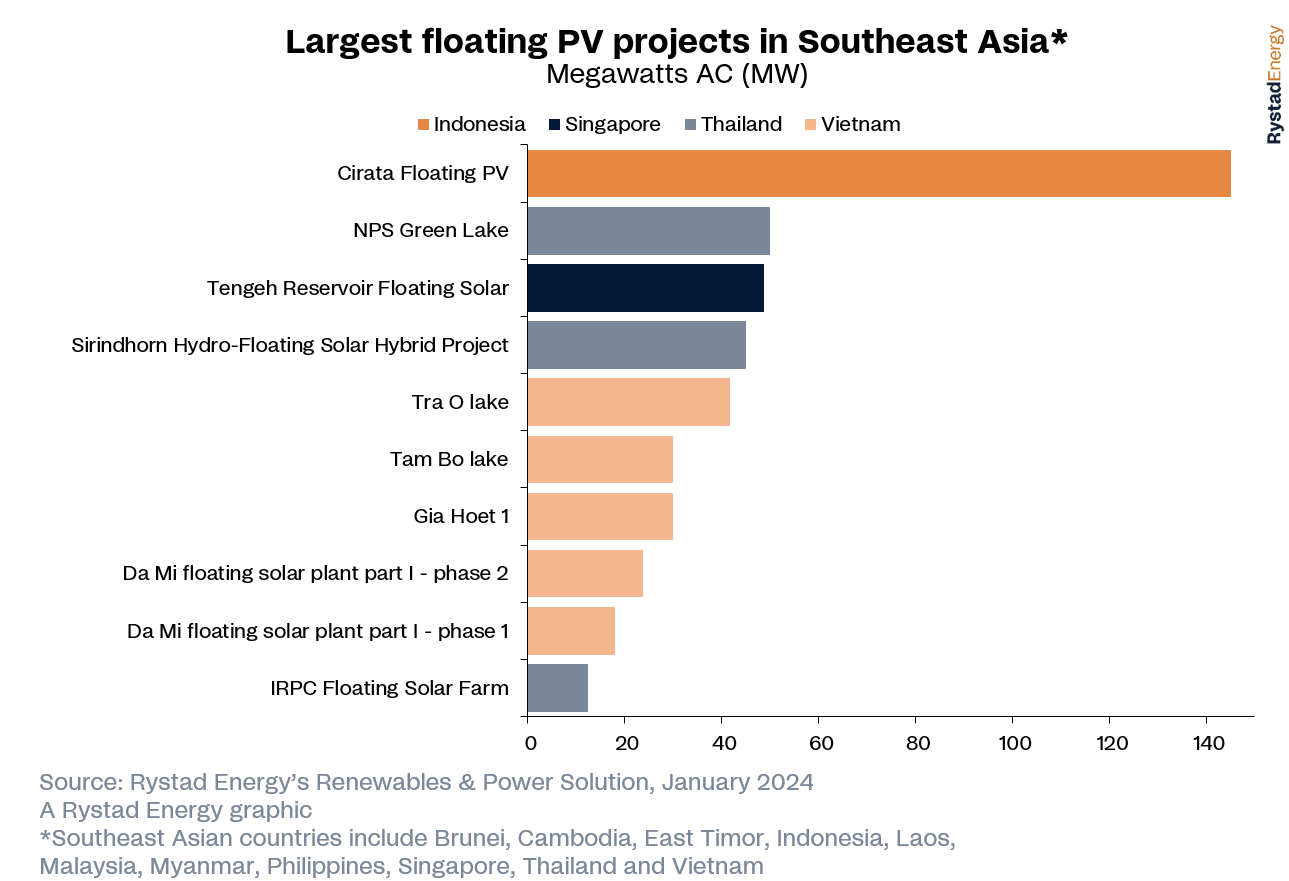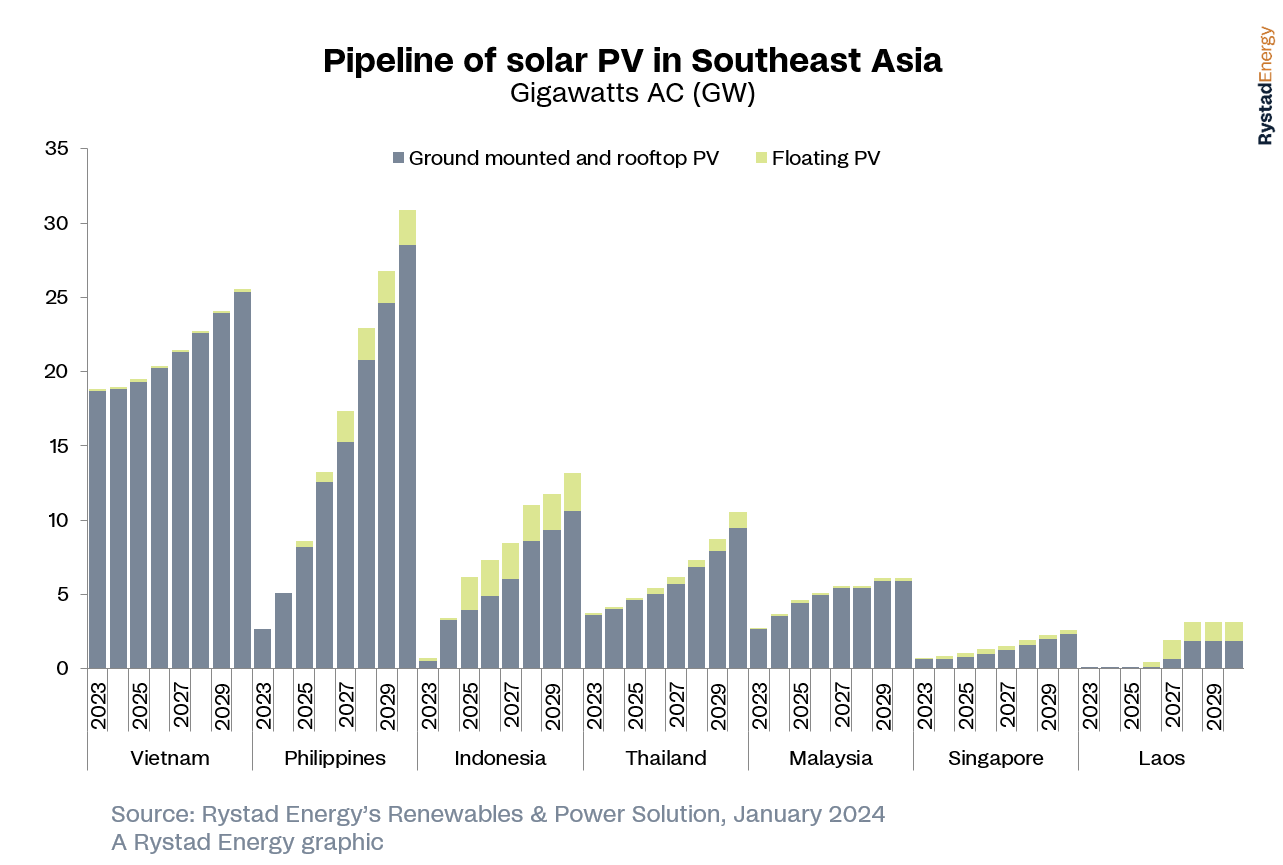Solar photovoltaic (PV) capacity additions are poised to be a central pillar of Southeast Asia’s energy future, with floating installations primed to play a critical role. Mirroring the broader Asian region’s dominance of the global floating PV (FPV) market, Rystad Energy research shows that Southeast Asia will account for 10% of the region’s total solar capacity by 2030, encompassing ground-mounted, rooftop and FPV installations. Countries such as the Philippines, Indonesia and Thailand are well-positioned to be at the forefront of this growing trend, using FPV to increase clean energy generation capacity.
Addressing land rights is a pivotal challenge for solar developers in Southeast Asia due to the predominant use of available land for agricultural purposes. The region grapples with a scarcity of suitable sites for solar farms, intensifying the need for innovative solutions. In particular, FPVs have emerged as a viable option, leveraging bodies of water adjacent to agricultural areas. This approach not only circumvents land access tensions but also presents a potential blueprint for other countries grappling with similar issues.
Operational FPV projects in Southeast Asia currently amount to around 500 MW combined. However, according to Rystad Energy’s data, an anticipated 300 MW of FPV capacity is expected to be added across Southeast Asia in early 2024 alone.
Currently, nine of the world’s top 10 FPV projects by size are in China, with the only exception being the Cirata FPV project in West Java, Indonesia, which was commissioned in November 2023. The project boasts capacity of 145 megawatts-alternating-current (MWac), setting an example that will be followed as more FPV projects enter the fold. Owned by the state utility Perusahaan Listrik Negara (PLN) and the Emirati renewable energy company, Masdar, the Cirata FPV project is the largest of its kind in Southeast Asia, surpassing others in mainland China and Taiwan (China).
FPVs have emerged as a game-changer for Southeast Asia, catalyzing the region’s push towards clean energy by maximizing its abundant solar resources and overcoming limited land availability. Their modular design allows for integration with existing hydropower dams and unlocks tremendous opportunities for hydropower-rich nations like Laos, Thailand and Indonesia. Additionally, with land rights a major deterrent facing solar developers in Southeast Asia, as much of the land is used for agriculture, FPVs provide a solution for the coexistence of solar farms and agriculture.
Jun Yee Chew, Head of Asia renewables and power research, Rystad Energy

Learn more with Rystad Energy’s Renewables & Power Solution.
In Thailand, companies are contracting FPVs and procuring electricity through private power purchase agreements (PPAs). This strategy is similar to rooftop solar leasing, with individuals or businesses leasing their rooftop space to solar companies. This symbiotic relationship allows landowners to power their businesses with clean energy while mitigating the risk of disputes between solar developers and farmers, who argue for the land to be used for agricultural purposes.
By maximizing this approach to land utilization, Southeast Asia can not only sidestep the intricate web of land rights issues but also promote the sustainable integration of solar energy. The success of the Thai model sets a precedent for navigating the delicate balance between agricultural needs and expanding renewable energy infrastructure and could set an example for the region at large. Additionally, with a significant portion of Southeast Asia covered by dense rainforests, FPV presents an opportunity to increase renewable energy generation without deforestation.

Indonesia, the Philippines and Thailand are expected to lead Southeast Asia’s push into floating solar in the years to come. As an archipelago, the Philippines has many large inland lakes that are suitable for FPV, such as Laguna Lake, where there are plans for nearly 3 gigawatts-alternating-current (GWac) of capacity.
Philippines-based ACEN is set to become the top FPV developer in Southeast Asia by the end of this decade. The company is working to commission a 1 GW project on Laguna Lake, along with a 200 MW project in the Filipino province of Rizal. ACEN currently has the largest and fastest-growing solar PV portfolio in the region, which will surpass 3 GW by the time the two FPV projects come online later this decade. Filipino solar company SunAsia and Singapore-headquartered Blueleaf Energy will also build a gigawatt-scale FPV in Laguna Lake, along with projects in other locations in the Philippines.
Indonesia’s extensive use of hydropower complements its ambition for more solar PV. The country has a 1.8 GW FPV project on the horizon at the Duriangkang reservoir in Batam, which is being led by Spanish-headquartered EDP Renewables. The development of FPV projects in Indonesia is expected to accelerate, given the temporary reduction in local content requirements for solar PV until 2025, when the nation’s first PV manufacturing plant is expected to come online.
More Top Reads From Oilprice.com:
- Energy Traders Thrive Amidst Europe’s Renewable Energy Surge
- Lawmakers Call for Tighter Control on Foreign Purchase of U.S. Farmland
- China's Surge in EV Exports to Europe Sparks Aluminum Industry Concerns


















